2023 TOYOTA PRIUS tow bar
[x] Cancel search: tow barPage 236 of 770
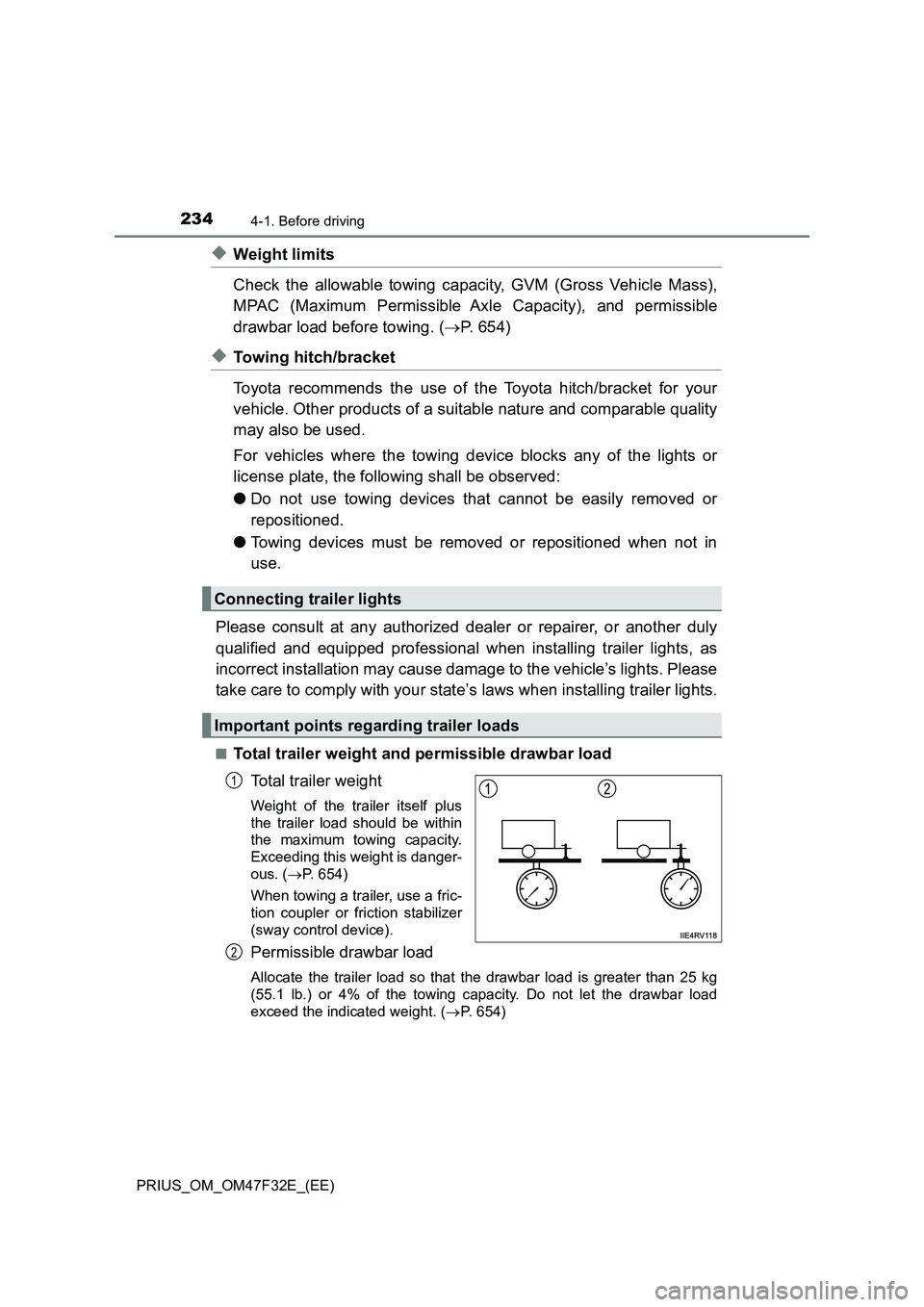
2344-1. Before driving
PRIUS_OM_OM47F32E_(EE)
◆Weight limits
Check the allowable towing capacity, GVM (Gross Vehicle Mass),
MPAC (Maximum Permissible Axle Capacity), and permissible
drawbar load before towing. (P. 654)
◆Towing hitch/bracket
Toyota recommends the use of the Toyota hitch/bracket for your
vehicle. Other products of a suitable nature and comparable quality
may also be used.
For vehicles where the towing device blocks any of the lights or
license plate, the following shall be observed:
●Do not use towing devices that cannot be easily removed or
repositioned.
●Towing devices must be removed or repositioned when not in
use.
Please consult at any authorized dealer or repairer, or another duly
qualified and equipped professional when installing trailer lights, as
incorrect installation may cause damage to the vehicle’s lights. Please
take care to comply with your state’s laws when installing trailer lights.
■Total trailer weight and permissible drawbar load
Total trailer weight
Weight of the trailer itself plus
the trailer load should be within
the maximum towing capacity.
Exceeding this weight is danger-
ous. (P. 654)
When towing a trailer, use a fric-
tion coupler or friction stabilizer
(sway control device).
Permissible drawbar load
Allocate the trailer load so that the drawbar load is greater than 25 kg
(55.1 lb.) or 4% of the towing capacity. Do not let the drawbar load
exceed the indicated weight. (P. 654)
Connecting trailer lights
Important points regarding trailer loads
1
2
Page 237 of 770
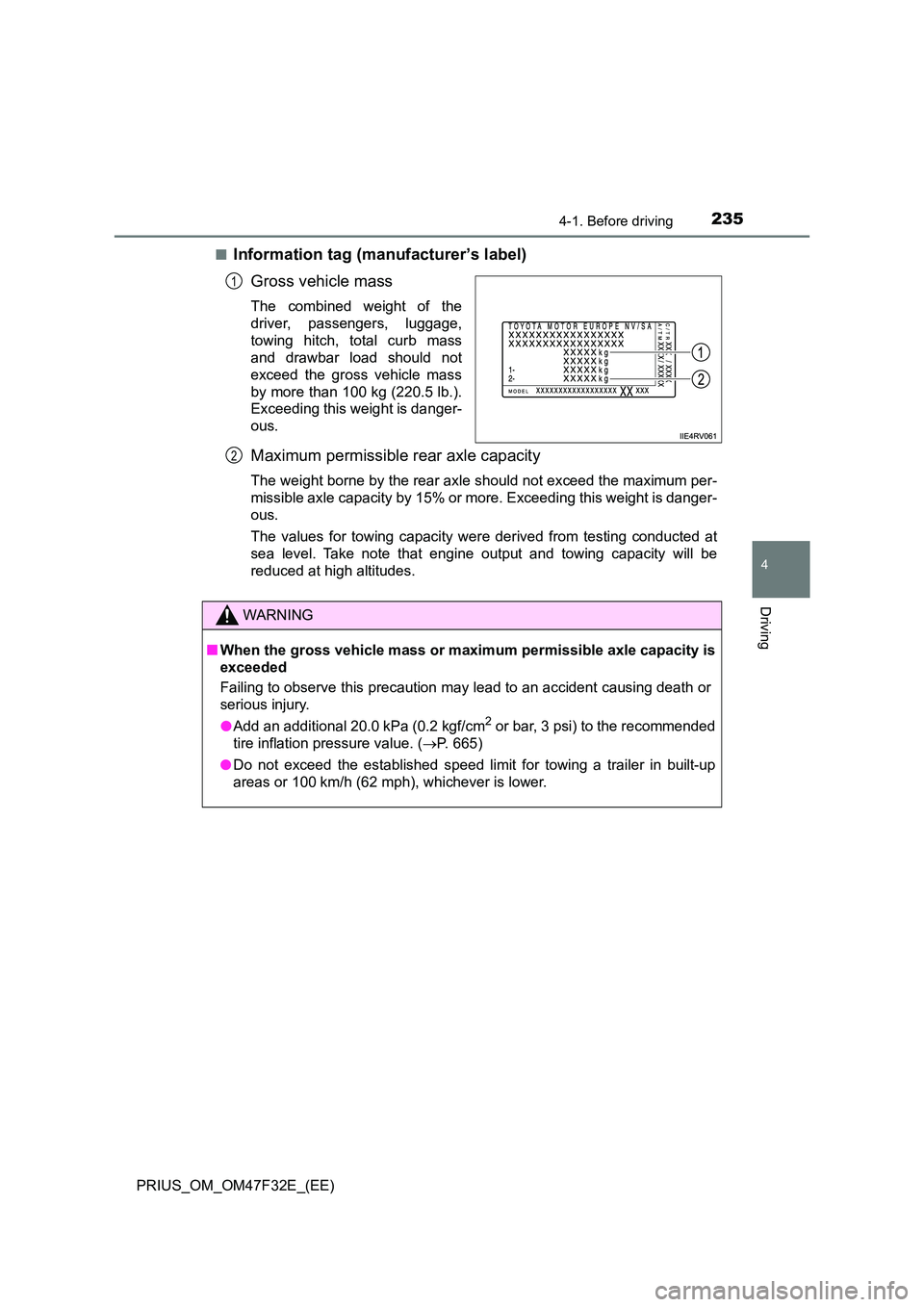
2354-1. Before driving
4
Driving
PRIUS_OM_OM47F32E_(EE)
■Information tag (manufacturer’s label)
Gross vehicle mass
The combined weight of the
driver, passengers, luggage,
towing hitch, total curb mass
and drawbar load should not
exceed the gross vehicle mass
by more than 100 kg (220.5 lb.).
Exceeding this weight is danger-
ous.
Maximum permissible rear axle capacity
The weight borne by the rear axle should not exceed the maximum per-
missible axle capacity by 15% or more. Exceeding this weight is danger-
ous.
The values for towing capacity were derived from testing conducted at
sea level. Take note that engine output and towing capacity will be
reduced at high altitudes.
1
2
WARNING
■ When the gross vehicle mass or maximum permissible axle capacity is
exceeded
Failing to observe this precaution may lead to an accident causing death or
serious injury.
● Add an additional 20.0 kPa (0.2 kgf/cm2 or bar, 3 psi) to the recommended
tire inflation pressure value. ( P. 665)
● Do not exceed the established speed limit for towing a trailer in built-up
areas or 100 km/h (62 mph), whichever is lower.
Page 240 of 770
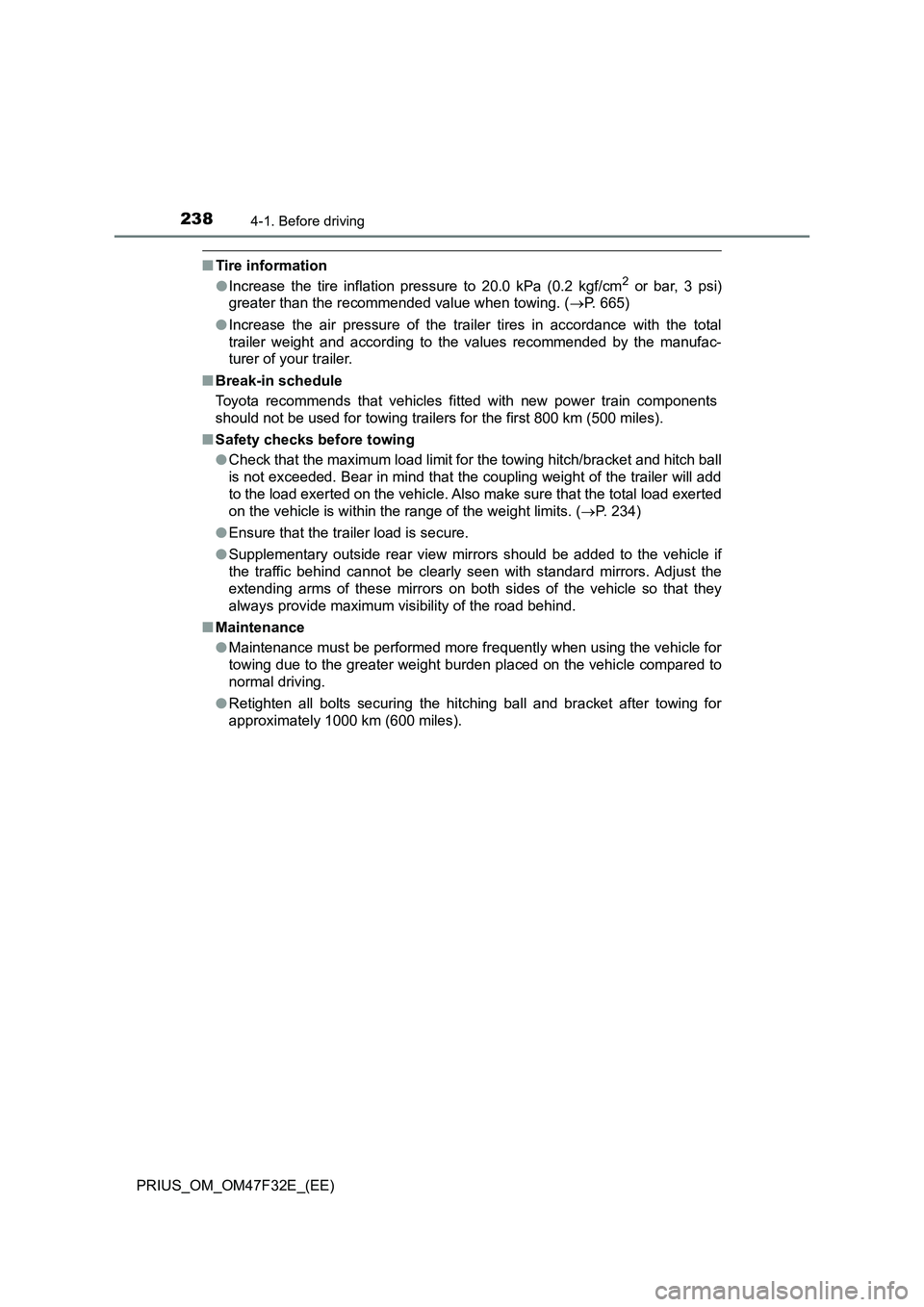
2384-1. Before driving
PRIUS_OM_OM47F32E_(EE)
■Tire information
●Increase the tire inflation pressure to 20.0 kPa (0.2 kgf/cm2 or bar, 3 psi)
greater than the recommended value when towing. (P. 665)
●Increase the air pressure of the trailer tires in accordance with the total
trailer weight and according to the values recommended by the manufac-
turer of your trailer.
■Break-in schedule
Toyota recommends that vehicles fitted with new power train components
should not be used for towing trailers for the first 800 km (500 miles).
■Safety checks before towing
●Check that the maximum load limit for the towing hitch/bracket and hitch ball
is not exceeded. Bear in mind that the coupling weight of the trailer will add
to the load exerted on the vehicle. Also make sure that the total load exerted
on the vehicle is within the range of the weight limits. (P. 234)
●Ensure that the trailer load is secure.
●Supplementary outside rear view mirrors should be added to the vehicle if
the traffic behind cannot be clearly seen with standard mirrors. Adjust the
extending arms of these mirrors on both sides of the vehicle so that they
always provide maximum visibility of the road behind.
■Maintenance
●Maintenance must be performed more frequently when using the vehicle for
towing due to the greater weight burden placed on the vehicle compared to
normal driving.
●Retighten all bolts securing the hitching ball and bracket after towing for
approximately 1000 km (600 miles).
Page 310 of 770

3084-5. Using the driving support systems
PRIUS_OM_OM47F32E_(EE)
WARNING
■Before using LTA system
● Do not rely solely upon the LTA system. The LTA system does not auto-
matically drive the vehicle or reduce the amount of attention that must be
paid to the area in front of the vehicle. The driver must always assume full
responsibility for driving safely by paying careful attention to the surround-
ing conditions and operating the steering wheel to correct the path of the
vehicle. Also, the driver must take adequate breaks when fatigued, such
as from driving for a long period of time.
● Failure to perform appropriate driving operations and pay careful attention
may lead to an accident, resulting in death or serious injury.
● When not using the LTA system, use the LTA switch to turn the system off.
■ Situations unsuitable for LTA system
In the following situations, use the LTA switch to turn the system off. Failure
to do so may lead to an accident, resulting in death or serious injury.
● Vehicle is driven on a road surface which is slippery due to rainy weather,
fallen snow, freezing, etc.
● Vehicle is driven on a snow-covered road.
● White (yellow) lines are difficult to see due to rain, snow, fog, dust, etc.
● Vehicle is driven in a temporary lane or restricted lane due to construction
work.
● Vehicle is driven in a construction zone.
● A spare tire, tire chains, etc. are equipped.
● When the tires have been excessively worn, or when the tire inflation pres-
sure is low.
● During emergency towing.
■ Preventing LTA system malfunctions and operations performed by
mistake
● Do not modify the headlights or place stickers, etc. on the surface of the
lights.
● Do not modify the suspension etc. If the suspension etc. needs to be
replaced, contact any authorized Toyota retailer or Toyota authorized
repairer, or any reliable repairer.
● Do not install or place anything on the hood or grille. Also, do not install a
grille guard (bull bars, kangaroo bar, etc.).
● If your windshield needs repairs, contact any authorized Toyota retailer or
Toyota authorized repairer, or any reliable repairer.
Page 392 of 770

3904-5. Using the driving support systems
PRIUS_OM_OM47F32E_(EE)
● If the orientation of a sensor has been changed due to a collision or other
impact
● When equipment that may obstruct a sensor is installed, such as a towing
eyelet, bumper protector (an additional trim strip, etc.), bicycle carrier, or
snow plow
● If the front of the vehicle is raised or lowered due to the carried load
● If the vehicle cannot be driven in a stable manner, such as when the vehicle
has been in an accident or is malfunctioning
● When tire chains, a compact spare tire or an emergency tire puncture repair
kit are used.
■ Situations in which the system may operate even if there is no possibil-
ity of a collision
In some situations, such as the following, the system may operate even
though there is no possibility of a collision.
● When driving toward a banner, flag, low-hanging branch or boom barrier
(such as those used at railroad crossings, toll gates and parking lots)
● When there is a rut or hole in the surface of the road
● When driving on a metal cover (grating), such as those used for drainage
ditches
● When driving up or down a steep slope
● If a sensor is hit by a large amount of water, such as when driving on a
flooded road
● There is dirt, snow, water drops or ice on a sensor. (Cleaning the sensors
will resolve this problem.)
● A sensor is coated with a sheet of spray or heavy rain
● When driving in inclement weather such as fog, snow or a sandstorm
● When driving on a narrow road
● When strong winds are blowing
Page 577 of 770
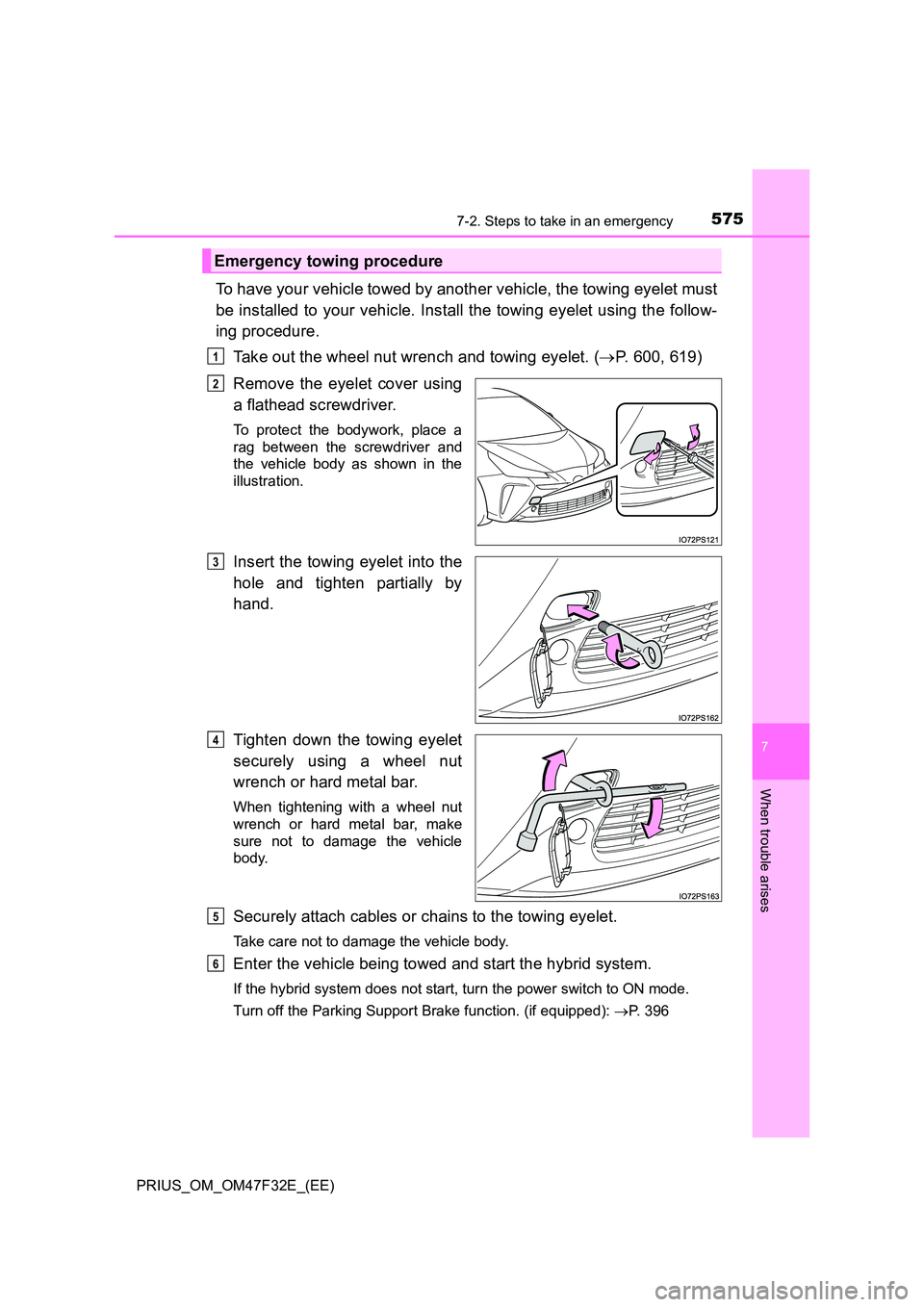
5757-2. Steps to take in an emergency
PRIUS_OM_OM47F32E_(EE)
7
When trouble arises
To have your vehicle towed by another vehicle, the towing eyelet must
be installed to your vehicle. Install the towing eyelet using the follow-
ing procedure.
Take out the wheel nut wrench and towing eyelet. ( P. 600, 619)
Remove the eyelet cover using
a flathead screwdriver.
To protect the bodywork, place a
rag between the screwdriver and
the vehicle body as shown in the
illustration.
Insert the towing eyelet into the
hole and tighten partially by
hand.
Tighten down the towing eyelet
securely using a wheel nut
wrench or hard metal bar.
When tightening with a wheel nut
wrench or hard metal bar, make
sure not to damage the vehicle
body.
Securely attach cables or chains to the towing eyelet.
Take care not to damage the vehicle body.
Enter the vehicle being towed and start the hybrid system.
If the hybrid system does not start, turn the power switch to ON mode.
Turn off the Parking Support Brake function. (if equipped): P. 396
Emergency towing procedure
1
2
3
4
5
6
Page 656 of 770
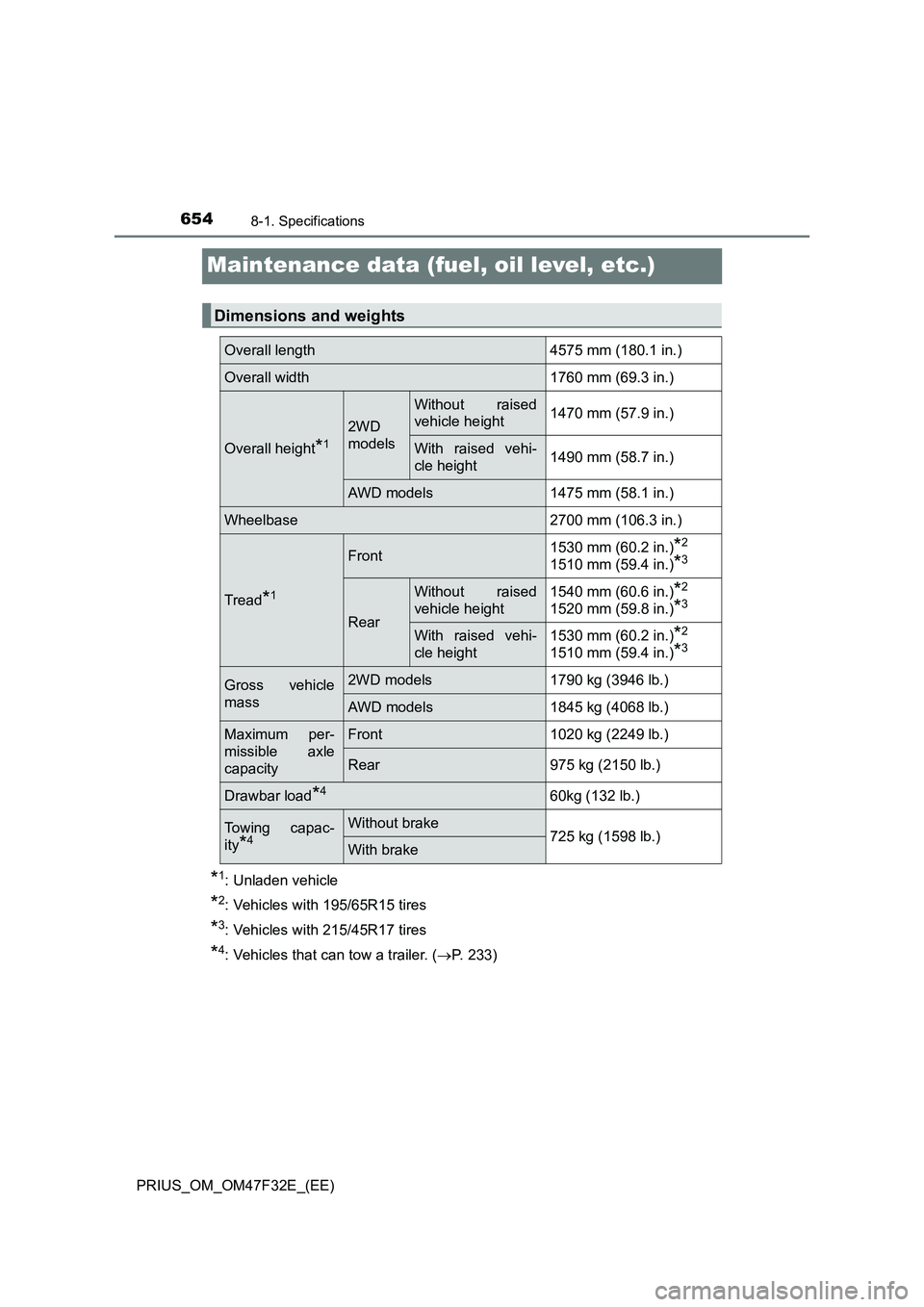
6548-1. Specifications
PRIUS_OM_OM47F32E_(EE)
Maintenance data (fuel, oil level, etc.)
*1: Unladen vehicle
*2: Vehicles with 195/65R15 tires
*3: Vehicles with 215/45R17 tires
*4: Vehicles that can tow a trailer. (P. 233)
Dimensions and weights
Overall length4575 mm (180.1 in.)
Overall width1760 mm (69.3 in.)
Overall height*1
2WD
models
Without raised
vehicle height1470 mm (57.9 in.)
With raised vehi-
cle height1490 mm (58.7 in.)
AWD models1475 mm (58.1 in.)
Wheelbase2700 mm (106.3 in.)
Tread*1
Front1530 mm (60.2 in.)*2
1510 mm (59.4 in.)*3
Rear
Without raised
vehicle height1540 mm (60.6 in.)*2
1520 mm (59.8 in.)*3
With raised vehi-
cle height1530 mm (60.2 in.)*2
1510 mm (59.4 in.)*3
Gross vehicle
mass2WD models1790 kg (3946 lb.)
AWD models1845 kg (4068 lb.)
Maximum per-
missible axle
capacityFront1020 kg (2249 lb.)
Rear975 kg (2150 lb.)
Drawbar load*460kg (132 lb.)
Towing capac-
ity
*4
Without brake725 kg (1598 lb.)With brake
Page 668 of 770

6668-1. Specifications
PRIUS_OM_OM47F32E_(EE)
Compact spare tire (if equipped)
■When towing a trailer*
Add 20.0 kPa (0.2 kgf/cm2 or bar, 3 psi) to the recommended tire inflation
pressure and drive at speeds below 100 km/h (62 mph).
*: Vehicles that can tow a trailer. (P. 233)
Tire sizeT125/70D17 98M
Tire inflation pressure
(Recommended cold tire
inflation pressure)
420 kPa (4.2 kgf/cm2 or bar, 60 psi)
Wheel size17 4T
Wheel nut torque103 N•m (10.5 kgf•m, 76 ft•lbf)